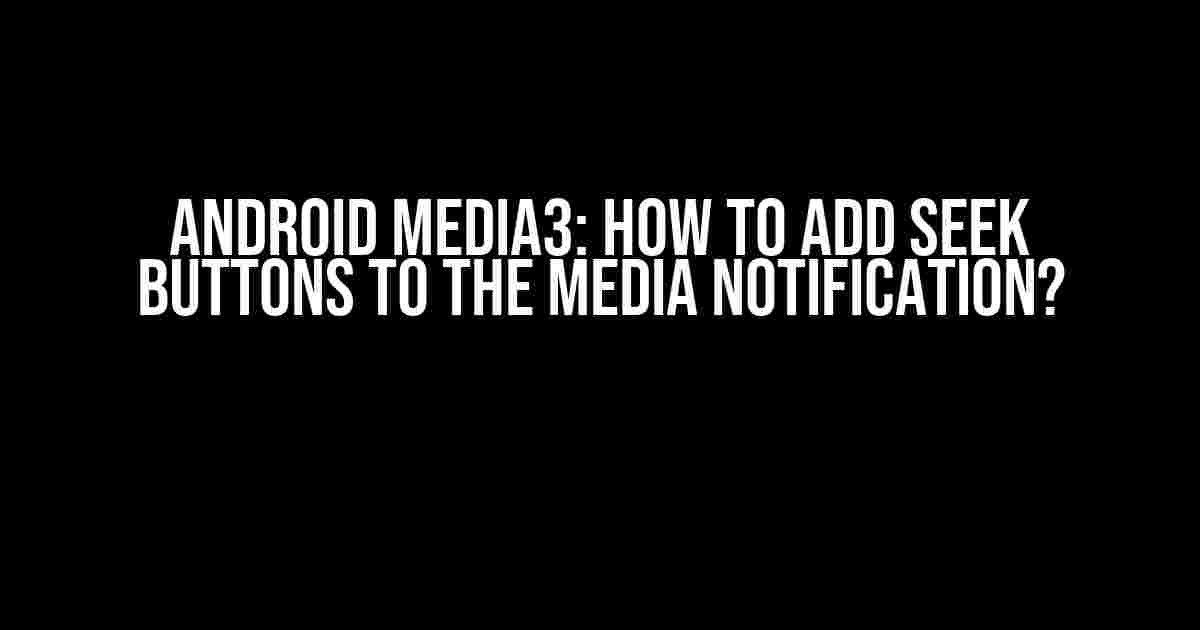Are you tired of using the default media notification controls in your Android app? Do you want to give your users a more interactive and engaging experience? Look no further! In this article, we’ll show you how to add seek buttons to the media notification using Android Media3.
What is Android Media3?
Android Media3 is a new media API introduced in Android 11 (API level 30) that provides a more efficient and flexible way of handling media playback. It replaces the old media APIs, such as `MediaSession` and `MediaPlayer`, with a more modern and modular architecture.
What are seek buttons?
Seek buttons are controls that allow users to jump forward or backward in a media playback. They are commonly used in music players, video players, and other media apps. By adding seek buttons to the media notification, you can provide your users with a more convenient way to control playback.
Step 1: Create a MediaSession
To add seek buttons to the media notification, you first need to create a `MediaSession` instance. A `MediaSession` represents a media playback session and provides a way to control playback, update metadata, and display notifications.
// Create a MediaSession instance
val mediaSession = MediaSession.Builder(context, "my_media_session")
.setSessionCallback(object : MediaSession.Callback() {
override fun onPlay() {
// Start playback
}
override fun onPause() {
// Pause playback
}
override fun onStop() {
// Stop playback
}
})
.build()
Step 2: Create a MediaNotification
A `MediaNotification` represents the media notification that is displayed in the notification shade. You can customize the notification by setting the title, text, and actions.
// Create a MediaNotification instance
val mediaNotification = MediaNotification.Builder(mediaSession)
.setNotificationId(1)
.setChannelId("my_notification_channel")
.setContentTitle("My Media App")
.setContentText("Now playing...")
.setSmallIcon(R.drawable.ic_notification)
.build()
Step 3: Add Seek Buttons to the MediaNotification
To add seek buttons to the media notification, you need to create a `MediaAction` instance and add it to the notification. A `MediaAction` represents a button that performs a specific action.
// Create a seek backward action
val seekBackwardAction = MediaAction.Builder("seek_backward")
.setIcon(R.drawable.ic_seek_backward)
.setListener(object : MediaAction.Listener() {
override fun onClick() {
// Seek backward 10 seconds
mediaSession.seekTo(mediaSession.currentPosition - 10000)
}
})
.build()
// Create a seek forward action
val seekForwardAction = MediaAction.Builder("seek_forward")
.setIcon(R.drawable.ic_seek_forward)
.setListener(object : MediaAction.Listener() {
override fun onClick() {
// Seek forward 10 seconds
mediaSession.seekTo(mediaSession.currentPosition + 10000)
}
})
.build()
// Add seek buttons to the notification
mediaNotification.addAction(seekBackwardAction)
mediaNotification.addAction(seekForwardAction)
Step 4: Display the MediaNotification
Finally, you need to display the media notification by calling the `show()` method.
// Display the media notification
mediaNotification.show()
Demonstration
Here’s a demonstration of the seek buttons in action:
 |
 |
Tips and Variations
Here are some tips and variations to consider when adding seek buttons to the media notification:
- Customize the seek button icons and text to match your app’s branding.
- Use different seek intervals, such as 30 seconds or 1 minute.
- Add more advanced seek functionality, such as seeking to a specific position or bookmark.
- Use a `SeekBar` instead of buttons to allow users to scrub through the media.
- Add a “Previous” and “Next” button to allow users to skip to the previous or next track.
Conclusion
In this article, we showed you how to add seek buttons to the media notification using Android Media3. By following these steps, you can provide your users with a more interactive and engaging media experience.
Remember to customize the seek buttons to match your app’s branding and functionality. With Android Media3, the possibilities are endless!
References
For more information on Android Media3, check out the official Android documentation:
I hope this article helps you create a more amazing media experience for your users! Happy coding!
Frequently Asked Question
Get ready to level up your Android Media3 game with these frequently asked questions about adding seek buttons to media notifications!
What is the main purpose of adding seek buttons to media notifications in Android Media3?
The primary purpose of adding seek buttons to media notifications is to provide users with a convenient way to control the playback position of their media content, such as songs or podcasts, directly from the notification shade. This enhances the overall user experience and makes it easier to navigate through long audio files.
Which Android version introduced the Media3 API, making it possible to customize media notifications?
The Android 11 (API level 30) introduced the Media3 API, which provides a more modern and flexible way to handle media notifications, including the ability to add custom actions like seek buttons.
How can I add seek buttons to my media notification using the Media3 API?
To add seek buttons, you need to create a `MediaSession` and a `MediaNotification` using the Media3 API. Then, you can add custom actions to the notification using the `addOnButton` method, specifying the seek forward and backward actions. Finally, handle the seek actions in your `MediaSession.Callback` implementation.
Can I customize the appearance and behavior of the seek buttons in my media notification?
Yes, you can customize the appearance and behavior of the seek buttons using various attributes and methods provided by the Media3 API. For example, you can set the button icons, text, and colors, as well as define the seek interval and behavior when the buttons are clicked.
Are there any limitations or restrictions when adding seek buttons to media notifications in Android Media3?
Yes, there are some limitations and restrictions when adding seek buttons to media notifications. For example, the Media3 API has specific guidelines for button placement and ordering, and you should ensure that your buttons comply with the Android design guidelines. Additionally, some devices or Android versions may have limitations on customizing media notifications.


